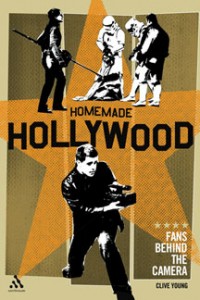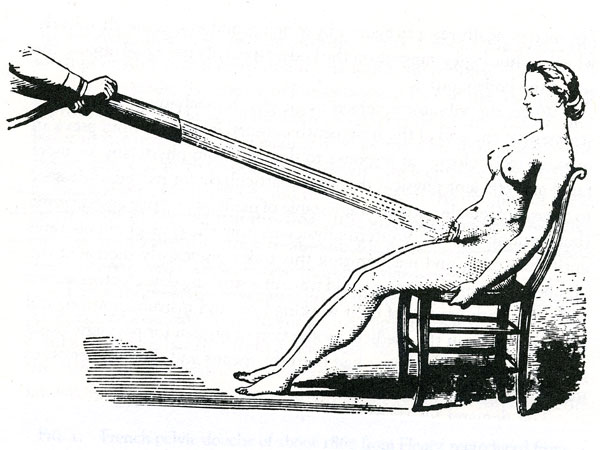“Relax yourself, girl / Please settle down….”
I may have finally cleared up for you what Q-Tip was actually saying (he told me himself) on the chorus of A Tribe Called Quest’s hit 1993 single, whose title I’ve also lifted for today’s post. But that track’s hook also summarizes the sentiment which drove the development of a medical implement that, today, is a common sexual aid: The vibrator.
In the 19th century, doctors were commonly diagnosing “hysteria” in female patients, a condition marked, according to historian Rachel P. Maines, in her book, The Technology of Orgasm, as characterized by ”anxiety, sleeplessness, irritability,  nervousness, erotic fantasy, sensations of heaviness in the abdomen, lower pelvic edema and vaginal lubrication.” Hysteria was treated by inducing “paroxysm” in the patient, massaging her genitals until this state was reached. Manual methods, like the water massage technique, illustrated above, were applied. The development of early steam- or manually-powered vibrators, though, enabled doctors to stop using their hands and fingers for this task, while electric vibrators, such as this jackhammer-looking model, above right, made the process even more efficient.
nervousness, erotic fantasy, sensations of heaviness in the abdomen, lower pelvic edema and vaginal lubrication.” Hysteria was treated by inducing “paroxysm” in the patient, massaging her genitals until this state was reached. Manual methods, like the water massage technique, illustrated above, were applied. The development of early steam- or manually-powered vibrators, though, enabled doctors to stop using their hands and fingers for this task, while electric vibrators, such as this jackhammer-looking model, above right, made the process even more efficient.
If you’ve just read the previous paragraph in semi-disbelief, then said to yourself, “Hold up: In the 1800s, people were going to the doctor so he could get you off?”, you’re halfway there. Most people today would recognize “hysteria” as feminine sexual arousal. By categorizing it as an illness, however, Victorians avoided messy and uncomfortable discussions about the complexity of female sexuality and desire, relegating those discussions to the physician’s office, where they were, subsequently muted through categorization of the woman’s horniness as an illness. (There was no male equivalent of hysteria.) Argue producer/directors Wendy Slick and Emiko Omori, in their documentary PASSION & POWER: The Technology of Orgasm (a lot of title-borrowing today), hysteria “was a disease manufactured by doctors creating a lucrative clientele and a mutually camouflaged procedure that satisfied both” doctors and their patients.
Wendy Slick is a guest today on my WBAI-NY / 99.5 FM radio show, NONFICTION, this afternoon, Friday, March 20, at 2 pm ET.
 But first, we’ll also talk with author Clive Young, whose new book, Homemade Hollywood: Fans Behind The Camera, right, traces another history: That of the so-called “Fan Film revolution—an underground movement where backyard filmmakers are breaking the law to create unauthorized movies starring Batman, James Bond, Captain Kirk, Harry Potter and other classic characters,” ones “which copyrights and common sense would never allow.” I wrote about Star Wars fan films for the much-lamented PREMIERE magazine, back in 2001, so I’m looking forward to the conversation.
But first, we’ll also talk with author Clive Young, whose new book, Homemade Hollywood: Fans Behind The Camera, right, traces another history: That of the so-called “Fan Film revolution—an underground movement where backyard filmmakers are breaking the law to create unauthorized movies starring Batman, James Bond, Captain Kirk, Harry Potter and other classic characters,” ones “which copyrights and common sense would never allow.” I wrote about Star Wars fan films for the much-lamented PREMIERE magazine, back in 2001, so I’m looking forward to the conversation.
You can hear Wendy Slick’s and Clive Young’s ideas by tuning in at 2 pm. If you’re outside of the New York tri-state, check out our stream on the web. If you miss the live show, dig into our archives for up to 90 days after broadcast.


0 comments ↓
There are no comments yet...Kick things off by filling out the form below.
Leave a Comment